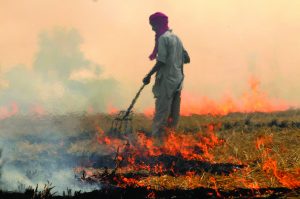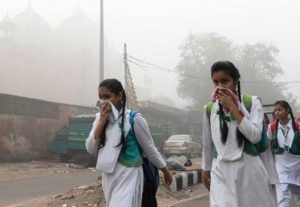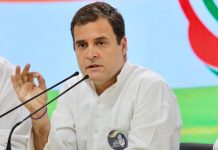 Delhi has again hit the no 1 position of being world’s most polluted city. The sight of people wearing masks have become popular and that day is not very far when we all have to carry oxygen cylinders to keep ourselves alive. In fact, the direction of destructive development in which we all are moving, we should just cut down the forests and invest in oxygen masks! Delhi’s peculiar topography makes it more vulnerable to pollution. If the air ceases to flow towards Delhi, the particulate matter settles faster.
Delhi has again hit the no 1 position of being world’s most polluted city. The sight of people wearing masks have become popular and that day is not very far when we all have to carry oxygen cylinders to keep ourselves alive. In fact, the direction of destructive development in which we all are moving, we should just cut down the forests and invest in oxygen masks! Delhi’s peculiar topography makes it more vulnerable to pollution. If the air ceases to flow towards Delhi, the particulate matter settles faster.
The main cause of panic is the presence of tiny particulate matter in the air known as PM 2.5 and PM 10. The size of these particulate matter is so tiny that they easily lodge themselves into our respiratory system. There are many causes of pollution in the capital city. The two big sources are stubble burning and vehicular pollution. The farmers of Punjab, Haryana and Uttar Pradesh are forced to burn the crop residue as it cannot be used for anything else. Unlike Bihar, where the rice crop residue is a food for the cattle but the stubble in Punjab and Haryana is full of so much pesticide and fertilisers that it cannot be used as fodder. So, they are left with no other option than burning. Delhi has the highest number of registered vehicles with 7.6 million of them. These vehicles are one of the largest and permanent source of pollution. Construction dust, industrial pollution, garbage burning are some of the other pollutants. The latest in the list was the burning of firecrackers during Diwali.
Cracker-full or
Cracker-free Diwali
The Supreme Court ordered only ‘green crackers’ to be sold and also restricted the time of bursting crackers from 8 pm to 10 pm only. But, both these orders were openly violated by the citizens as well as the police and administration. First of all, neither the cracker sellers nor the buyers were aware of ‘green crackers’. These ‘green crackers’ with low hazardous chemicals have not been produced or sold in India yet. The cracker sellers sold their traditional crackers in the name of ‘green crackers’. Post Diwali night, Delhi NCR emerged to be the most polluted spot on the planet. There was a huge failure on the part of the police to strictly implement the Supreme Court guidelines.
Air Quality Index (AQI) is a measure used by the government to communicate to the people how polluted the air is.
An AQI between
0 and 50 is good
51 and 100 is satisfactory
101 and 200 is moderate
201 and 300 is poor
301 and 400 is very poor
401 and 500 is severe
Beyond 500 is hazardous
On the next day of Diwali, the AQI at Chanakyapuri, Central Delhi (which is one of the greenest part) was 459 and the AQI of Anand Vihar in East Delhi which hardly has any trees was 999. This, in itself reflects the role our trees play in reducing the pollution level. There is also an interesting fact here. AQI was actually more than 2000 in some parts and not just 999 but our machines are not designed to capture more than 3 digits.
But, it is not just Delhi. More than 41 cities in North and Central India recorded ‘Very poor’ to ‘Severe’ AQI post Diwali. Noida, Faridabad, Patna and Lucknow recorded worse air quality than even Delhi.
Doctors called the pollution level of Delhi NCR as ‘health emergency’. Dr.Arvind Kumar who attended WHO’s first Global conference on Pollution held in November 2018 and is one of the country’s finest chest surgeon said, “I hardly see normal pink lungs these days. Everybody’s lungs have black deposits on them which are causing a silent damage. Today, breathing kills, in a city like Delhi.”
 Air pollution not just causes respiratory diseases but also leads to heart problems, brain attacks, reproductery problems and many other issues. A recent study has found that pollution also causes reduction in intelligence.Air pollution is proving deadly specially for
Air pollution not just causes respiratory diseases but also leads to heart problems, brain attacks, reproductery problems and many other issues. A recent study has found that pollution also causes reduction in intelligence.Air pollution is proving deadly specially for
children. As per WHO, 600,000 children died of respiratory diseases in 2016. A 16 year old student Kabeer suffering from respiratory disorders asked, “Diwali is celebrated on the occasion of return of Lord Rama to Ayodhya. There is no mention of bursting crackers in Ramayana. Crackers were not even invented when Lord Rama returned to Ayodhya, then why do we burst crackers now?”
The most ironic part of Delhi’s Diwali was sight of people burning crackers while wearing masks. Their love for the polluting crackers was so much that they are ready to burn them while putting their lungs at risk. Apart from the patients suffering from lung diseases, Diwali is also a festival of terror for our furry friends. It is mating season for dogs. And, puppies born are only a few days old, so they undergo a horrifying situation. If you observe, on a Diwali evening, there are no dogs on streets as they hide themselves to escape the so called human way of celebration.
The Solutions
As mentioned in my previous article on pollution, here are some long term measures the citizens and the government must take to make the air healthy.
No more trees specially those which are 40 to 200 years old should be allowed to be cut in the name of development. Trees play the most important role in controlling pollution and providing fresh air. The NBCC and CPWD projects of central government plans to cut more than 20,000 fully grown trees in South Delhi. Aravali Biodiversity park having rich wildlife and birds is in danger because of road construction by NHAI. Trees are being cut in several other corners of NCR in the name of construction and progress. But, enough damage has been done to the city. Delhi needs at least 33per cent forest cover as per National Forest Policy but it possesses only 20per cent green coverage. We are already short of 13per cent green coverage and still the government plans to cut more trees. The govt and the citizens must do as much plantation as possible and the work doesn’t end here. We need to take care of the sapling till at least one year of its growth so that it survives.
Measures should be taken to reduce further concretisation of the city. Even if there is a plan to do new construction, green building norms should be followed. This can at least be implemented on all government constructions to start with. A minimum percentage of green area should be maintained in every building. Public transport must be made more frequent. The number of public buses specially the electric buses should be increased. People should be motivated to use public transport by reducing metro and bus fare and giving other attractions.
Heavy taxes should be imposed on buying of new private cars to reduce the number of vehicles on the road. Blanket ban should be imposed on buying of new diesel vehicles. 10 to 15 year old diesel vehicles should also be brought off the roads.There should be incentive towards car pooling both by private companies and the government.Do not burn the landfills instead develop a proper waste segregation and management system from its source. Alternative technologies for crop burning like turning crop residue into disposable tableware should be encouraged and promoted by the govt.
Above are some imperative long-term measures that govt must take to prevent Delhi’s air from getting spoiled further. While, here are some temporary relief measures that an individual can take to protect themselves from pollution.
Since most people in Delhi NCR live in apartments, they can have terrace or balcony garden. Also growing indoor plants like Areca Palm, Lady Palm, Bamboo palm, Rubber Plant can help in naturally purifying the air.People should try avoiding the use of private transport to reduce emission of pollutants.
 Try and stay indoors if possible. Do not burn any crackers on Diwali, weddings or any other occasion. Fitness of your lungs is more important than a fraction of excitement that you get after watching the crackers. Do exercise everyday early in the morning or late evening as exercise keeps the lungs healthy.
Try and stay indoors if possible. Do not burn any crackers on Diwali, weddings or any other occasion. Fitness of your lungs is more important than a fraction of excitement that you get after watching the crackers. Do exercise everyday early in the morning or late evening as exercise keeps the lungs healthy.
One can buy Air Purifiers as a temporary relief but personally I am not very much in favour of air purifiers as it may clean the air inside but it pollutes the outside air further more.
Those having asthma or other lung problems must keep their medicine handy. Tomatoes, apples, broccoli, spinach, flaxseed are some of the food items that will help in reducing the impact of pollutants on your body. So, consume them often. Wear masks when ever you move out of the house and carry them always with you.
Innovations to clean the air
Its an age of innovations and startups. Pollution has emerged to be a major problem and many innovators are trying to solve it. Some of such innovations are. Pracheer Dutta, incubated in IIT Delhi has developed a technology by which crop residue can be converted into pulp which is used to make value added products like disposable tableware. He is putting an effort to utilise the crop residue of Punjab and Haryana and make disposable plates from it. So, what is being burnt today causing so many harmful effects could be an additional source of income for the farmers and would also replace plastic.
Union Environment Minister Dr. Harsh Vardhan flagged off five buses fitted with air-filters which trap the pollutants in the air. These air-filters were designed by Faridabad based Manav Rachna Innovation and Incubation Centre (MRIIC). The filters can tap upto 98per cent particulate matter thus keeping the air, pollutant free.
Chakr Innovation founded by IIT Delhi alumnus converts particulate matter emissions from diesel generators into inks and paints. The ink made from pollutants is used for computer printing.
Nasofilters uses nanotechnology to filter pollutants while breathing. It can be worn over nostrils and used for 12 hours. Unlike traditional face masks, this doesn’t block breathing. It is available on Amazon, Flipkart, Paytm and Apollo Pharmacy stores in Delhi.
Delhi based Kurin systems has come up with a 40 feet air purifier than can provide clean air to around 75,000 people in a radius of 3 kms. This air purifier has been considered to be ‘World’s largest and strongest air purifier.’ This device won’t need electric grids to function as it can run solely on solar power.
Other aspect of environmental degradation
‘Fake’ encounter of Tigress Avni
Tigress Avni was killed in Maharashtra’s Yavatmal forest in a fake encounter on the orders of Maharashtra government. She is survived by her two young cubs of 10 months old. She was shot dead by sharp-shooter Asgar Ali, son of famous shooter Nawab Shafat Ali. The post mortem report of Tigress Avni revealed that she had not eaten for more than a week. This means, her cubs are also hungry and forest officials are in search for them.
The killing was done because the government sold the Yavatmal forest which was Avni’s habitat to Anil Ambani to build a cement factory. Although the govt used the excuse of Avni being a man eater tigress which had killed 13 villagers. However, there is no scientific proof of these 13 people being killed by Tigress Avni. Also, the label ‘man-eater’ contradicted the “Guidelines of Declaration of Big Cats as Man-eaters”, which state that a tiger can only be deemed a danger to humans if he or she ventures into human territory and kills someone. However, the deaths that the Maharashtra Forest Department attributed to Avni were results of humans entering tiger territory, possibly for cattle grazing in forest reserve.
As I write this, the two cubs of Avni are also being hunted. The government is claiming that they would be tranquillised and rescued but there is no assurance. I sincerely pray that the cubs don’t meet Avni’s fate. The animal lovers are raising their voice against the killing of Avni and are praying for the safety of her two cubs. Anand Siva, an animal activist who is dedicatedly working on the issue said, “Avni is an eye opener on the corrupt practices in our country. Not just the Indians but even the world is joining hands to raise their voice against the illegal killing of Tigress Avni.” Several rounds of protests were organised all across the country to show that the people will no longer stay quiet on these killings. This is the first time, that the common man is actually coming on streets in large numbers to fight for the rights of animals.
 A global march and prayer was held in different parts of India and the world on 11 November 2018 to demand justice for illegal killing of Avni and create awareness and attention towards conservation of wildlife. The protest was conducted across 25 cities in India and 10 cities internationally. Anuragini Shiddhat, a young crusader who is aggressively uniting people in raising the voice said, “She is doing it for Avni and all other animals because these are voiceless creatures and they cannot speak for themselves. Also, there are several organisations workings towards human related problems but there are very few fighting for protection of wildlife and animals.”
A global march and prayer was held in different parts of India and the world on 11 November 2018 to demand justice for illegal killing of Avni and create awareness and attention towards conservation of wildlife. The protest was conducted across 25 cities in India and 10 cities internationally. Anuragini Shiddhat, a young crusader who is aggressively uniting people in raising the voice said, “She is doing it for Avni and all other animals because these are voiceless creatures and they cannot speak for themselves. Also, there are several organisations workings towards human related problems but there are very few fighting for protection of wildlife and animals.”
Coming on the political aspect, before Avni was killed, there were hardly any political voices on the issue. Everyone was keeping mum including Maneka Gandhi who is believed to be the strongest voice for wildlife protection. After Avni was shot on 2 November 2018, politicians jumped in seeking their own brownie points.
Congress Chief Rahul Gandhi tweeted, “The greatness of a nation can be judged by the way its animals are treated. #Avni.”
Union Minister Maneka Gandhi criticised Maharashtra govt and the involvement of sharp shooter Nawab Shafat Ali and his son Asgar Ali into the case. She said, “Asgar Ali was not authorised to kill. This is patently illegal. Despite the forest officials being committed to tranquillise, capture and quarantine the tigress, the trigger-happy shooter has killed her on his own, under the orders of Maharashtra Forest Minister Sudhir Mungantiwar.” Shiv Sena leader Aditya Thackeray, too, slammed the state government for killing Avni. The Pashu Chikitsak Mahasangh also questioned the Maharashtra government for assigning the task of capturing Avni to a private hunter, who is not a registered veterinarian. Unfortunately, when Avni was being shot at, there was no registered veterinarian present to tranquillise her.
After demands for a NIA probe by the protestors, government has ordered two investigations into the Avni killing case. At the Central level, National Tiger Conservation Authority (NTCA) and at the State level Maharashtra government is investigating the case. Sharpshooter Shafat Ali Khan said he is ready to face any probe into the shooting of Tigress Avni.
Plundering the Planet
Avni’s killings gained so much attention because it is not just about one Tigress. Its about the existing situation of wildlife in general. We are left with just 3900 tigers across the globe and despite that we ‘humans’ are mindlessly butchering all other species on Earth. Within just two days of Avni’s murder, another tiger was killed in Dudhwa, Uttar Pradesh where the villagers crushed the tiger using a tractor for mauling down a 50-year-old man. Royal Bengal Tigress Sundari from Satkosia, Odissa was tranquillised and brought to a Zoo in Bhubaneswar.
In most European and developed countries, hunting is legal. Consequently, a majority of their wildlife has been killed. Wildlife isn’t encroaching human habitat, its actually the humans who has encroached the wildlife’s habitat.
India has one of the strongest wildlife conservation laws. Yet, poaching has been a major issue. According to Wildlife Protection Society of India, 38 tigers died due to poaching and seizures in 2017 and 26 tigers have been poached and killed in 2018. 159 leopards were poached in 2017 and 135 leopards died due to poaching and seizures in 2018. There should be more stringent punishment for poachers.
Today, due to years of illegal hunting, a lot of forests in India have become silent forests i.e. forests with no animal presence.For example, most leopards living in the Himalayan foothills now have to regularly enter villages to pick up street dogs for their survival as the natural prey-base of the surrounding forests has been destroyed by man.
Man-Animal Conflict, A Land issue!
So, the entire man-animal conflict is a land and water issue. Humans are intruding into the forests thus taking away the food and shelter of the animals giving rise to the conflict. So, it is not the tigers, leopards and elephants that has to be blamed for entering the human territory but restrictions have to be put on human activity. Human population needs to be controlled as the planet is left with very limited resources and humans are eating away all resources without leaving anything for all other species.
Forest corridors play a very important role in growth of tiger and leopard species as it gives
them space for improving their breed. And at the same time, most of the forest encroachments happen in forest corridors. 23per cent of India’s land i.e. 764,000-lakh sq km of forest cover has been encroached by humans for agricultural, housing and industrial purposes.
Wildlife is the greatest gift of Mother Earth which cannot be brought back if lost. Just like Africa, India should look at wildlife as its greatest asset than liability. We should be promoting wildlife and sustainable tourism. It is one of the best ways to earn green dollars and mitigate the man-animal conflict and also create the spirit of conservation among the people.
Abhishek Ray, a tiger tracker and conservator bought an entire hill in Jim Corbett, Uttarakhand and gave it to the wildlife. He allowed the forest to grow as it is with no human intervention and today a land which was a forest corridor and a major source of man-animal conflict is a thriving place for tigers, leopards, 650 species of birds and lot of wildlife. Ray who is also a music composer said, “We all must buy land and give it to the wildlife, only then we will be able to save them.”
Re-wilding
Recent report by WWF have brought into notice that humans have wiped out 60 per cent of the wildlife since 1970. The report prepared by 59 scientists across the globe mentions that due to growing need of food and other resources, humans are massacring birds, fishes, mammals, reptiles thus destroying the entire planet. Mike Barrett, executive director of science and conservation at WWF said, “If 60 per cent of the human population was wiped out, it would have been equivalent to combined population of North America, South America, Africa, Europe, China and Oceania.”
Wildlife specially predators like tigers are an indicator of fresh water and air, so by killing them we are also putting our own future into danger.The only way of mitigating climate change is to re-wild and stop the diversion of existing forests.
At a time when everything seems to be gloomy, there is a Swiss philanthropist Hansjörg Wyss who is donating $1billion to save 30per cent of Earth in its natural state. He would be donating this money over a period of 10 years to keep the forests and the oceans clean.
When we don’t have fresh air to breathe and fresh water to drink, what will we do with all the amenities which we have created under the so called ‘development’ ! So, think again and invest in re-wilding.
letters@tehelka.com










